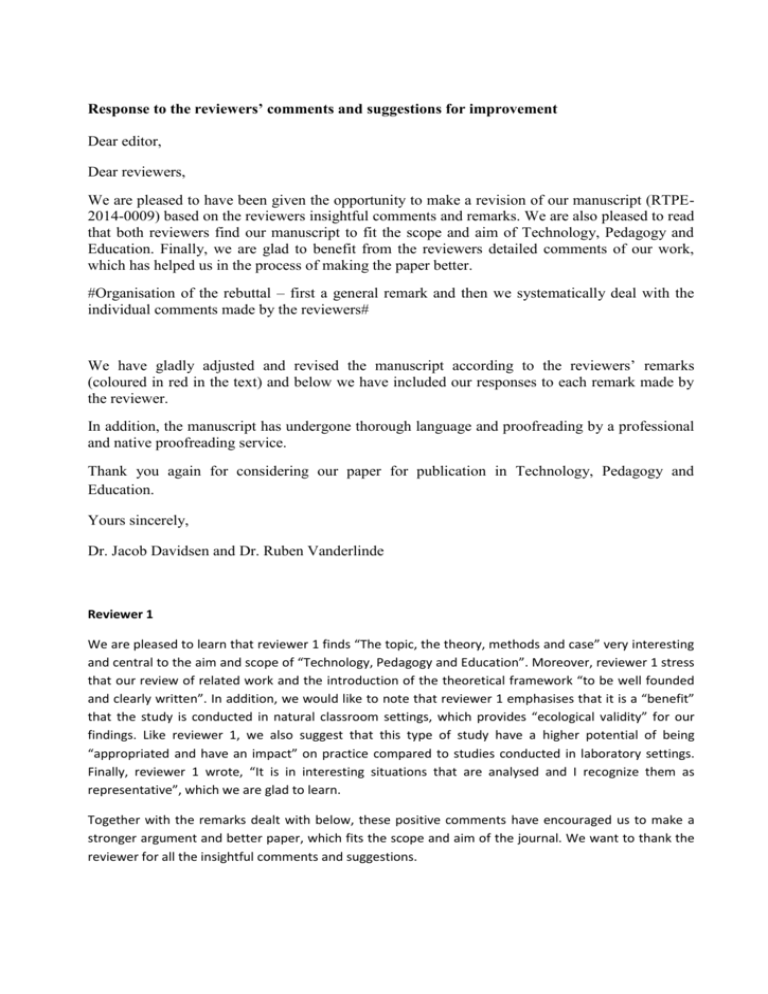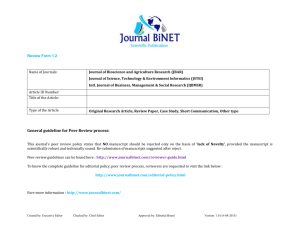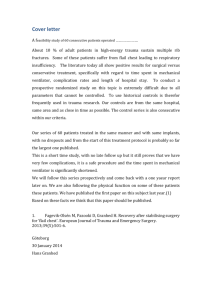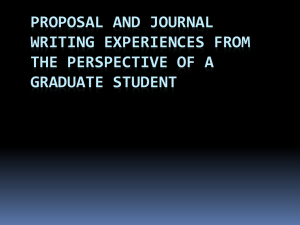Rebutal_work together now children_211014
advertisement

Response to the reviewers’ comments and suggestions for improvement Dear editor, Dear reviewers, We are pleased to have been given the opportunity to make a revision of our manuscript (RTPE2014-0009) based on the reviewers insightful comments and remarks. We are also pleased to read that both reviewers find our manuscript to fit the scope and aim of Technology, Pedagogy and Education. Finally, we are glad to benefit from the reviewers detailed comments of our work, which has helped us in the process of making the paper better. #Organisation of the rebuttal – first a general remark and then we systematically deal with the individual comments made by the reviewers# We have gladly adjusted and revised the manuscript according to the reviewers’ remarks (coloured in red in the text) and below we have included our responses to each remark made by the reviewer. In addition, the manuscript has undergone thorough language and proofreading by a professional and native proofreading service. Thank you again for considering our paper for publication in Technology, Pedagogy and Education. Yours sincerely, Dr. Jacob Davidsen and Dr. Ruben Vanderlinde Reviewer 1 We are pleased to learn that reviewer 1 finds “The topic, the theory, methods and case” very interesting and central to the aim and scope of “Technology, Pedagogy and Education”. Moreover, reviewer 1 stress that our review of related work and the introduction of the theoretical framework “to be well founded and clearly written”. In addition, we would like to note that reviewer 1 emphasises that it is a “benefit” that the study is conducted in natural classroom settings, which provides “ecological validity” for our findings. Like reviewer 1, we also suggest that this type of study have a higher potential of being “appropriated and have an impact” on practice compared to studies conducted in laboratory settings. Finally, reviewer 1 wrote, “It is in interesting situations that are analysed and I recognize them as representative”, which we are glad to learn. Together with the remarks dealt with below, these positive comments have encouraged us to make a stronger argument and better paper, which fits the scope and aim of the journal. We want to thank the reviewer for all the insightful comments and suggestions. Comment 1 “The review together with the analytical framework promises a bit more than what the case delivers, e.g. what does the present study contribute with that other studies have not shown before, and what is the additional contribution from embodied interaction analysis? This needs to be better argued for in the closing discussion to justify the claims made in the first part of the article.” As suggested by reviewer 1, we have taken the relation between the related work and our study up in the closing discussion. We have especially sought to clarify in which ways our study contribute insights to the field of children’s collaborative activities around touchscreens. In addition we have emphasised that this type of study provides ecological validity in contrast to the laboratory studies introduced in the related work section. Together, these additional lines of text also deal with the contribution provided by embodied interaction analysis. Basically, embodied interaction analysis was used as a methodological and theoretical lens for understanding the children’s collaborative interactions. Finally, embodied interaction analysis offers a holistic and context sensitive approach zooming in on the participants “doings” in their local environment with the present semiotic resources. In contrast to the laboratory studies, we emphasis the children’s embodied methods for engaging/disengaging in collaborative learning (see revised text on page 22). See page 21-23 for the all the revisions. Comment 2 “…the review can be better attuned to the empirical findings in the study” We agree with reviewer 1 and have attuned the empirical findings to the related work in the closing discussion. We have added the following lines of text (page 22): “In contrast to the coding and counting studies conducted in laboratory settings, embodied interaction analysis offers a holistic and context sensitive approach zooming in on the participants “doings” in their local environment with the present semiotic resources at hand. Thus, our findings emphasis the children’s embodied methods for engaging/disengaging in collaborative learning, which is neglected by the coding and counting studies. “ Comment 3 Reviewer 1 requests a more thorough introduction to project “Move and Learn”, as the long term project in the classrooms provides ecological validity to our findings, which according to the reviewer is strength and quality of the paper. We have added additional information about the project, and strongly believe that it qualifies the ecological validity of our analyses, narrative cases and findings. In particular, we added the following lines of text (see page 10): “Several pedagogical issues emerged during the project for both teachers and children. The teachers were confronted with pedagogical issues of designing for children’s collaboration and of finding an appropriate form of facilitation of the children’s collaborative processes around the touchscreen, e.g. which designs will foster collaborative interactions among the children and how to guide and facilitate children’s collaborative activities. Likewise, the children had to develop methods for engaging/disengaging in collaborative activities, e.g. find methods for dealing with social, technical and academic issues. The teachers were developing ways of integrating the touchscreens into both the learning processes (how children learn) and the subject-specific content (what they learn). Hence, the teachers explored the affordances of this setup in their practice, e.g. what tasks promoted collaborative interactions between the children. The teachers did not base their exploration on any theoretical or methodological position suggested by the researchers, however, the teachers and researchers did meet for video feedback sessions. In these sessions, the teachers and researchers viewed situations from the classrooms together thereby learning together and from each other (Davidsen & Vanderlinde, 2014b). In many ways, these sessions shaped the professional vision (Goodwin, 2000) of both teachers and researchers.” Comment 4 The reviewer requires a comprehensive introduction and description of the data collection procedure and data analysis procedure. In particular, the reviewer raised the question of whether “the researcher was present all the time during data collection, or perhaps the teacher recorded some data?”. First of all, we want to clarify that the teachers did collect a substantial amount of the video data (see page 11 “Data collection”). Second, we have, based on the reviewer’s comment, included a thorough introduction to the data collection procedure and the data analysis procedure (see page 11 and 12). Among other things, we described how we located the three situations in the collected data material using Transana. In addition, we have decided to include an example of our detailed multimodal transcripts in order to illuminate our data analysis procedure in more detail (see figure 3, page 13). In total, we have provided a comprehensive introduction to each phase of our work with the data. To be precise, we have 1) illuminated the teachers role in the data collection phase, 2) presented how we found the three situations using Transana and 3) illustrated how we used detailed multimodal transcripts as resources for writing the narrative cases on page 11, 12 and 13. Comment 5 Reviewer 1 makes a remark on the procedure of data selection, and we are pleased to benefit from the reviewer’s insightful reading of our manuscript. We have taken this very seriously and elaborated on the process of selecting the data used for the three narrative cases. In other words, we have done a second round on the empirical analysis as requested by the reviewer. In addition, we have included an example of a detailed multimodal transcript in order to illuminate the basis for producing the three narrative cases. To be explicit, we have added the following lines of text, which clarifies the process of finding the three cases (see page 13): “The three cased were selected from a larger collection of clips where teachers where were guiding pairs in the classrooms. In total, we found a preliminary collection of 248 situations where the teachers were guiding the children with technical, social or collaborative issues. For showing the teachers facilitation of the children’s collaborative processes, we selected three representative cases illustrating children’s embodied methods for engaging/disengaging in collaboration, and the teacher design for and guiding of the children’s collaborative interactions.” Based on ethnomethodology, we present three narrative cases which illuminate aspects of children collaborative activities around touchscreens. In addition, we make an effort to show the children’s embodied methods for engaging/disengaging in collaboration by integrating a series of stencil drawings capturing the children’s embodied collaborative interactions (see page xx, yy and zz). In other words, we analyse and present the cases as they unfold without converting the children’s interactions into coding categories. Comment 6 The reviewer wants us to demonstrate what our study contributes to existing studies on both the empirical and theoretical level. This is now a part of the closing discussion (see page 22), which reads: “In contrast to the coding and counting studies conducted in laboratory settings, embodied interaction analysis offers a holistic and context sensitive approach zooming in on the participants’ mundane “doings” in their local environment with the present semiotic resources at hand. Thus, our findings emphasis the children’s everyday embodied methods for engaging/disengaging in collaborative learning, which is neglected by the coding and counting studies. For example, we have abstained from comparing paper-based interaction and touch-based interaction (Higgins, Mercier, Burd, & Hatch, 2011), as we are interested in understanding how children use the touchscreens as a part of the assemblages of material resources for orchestrating their collaboration.” In total; these additional sentences demonstrate our contribution to the existing studies. To sum up, we show children’s embodied methods for engaging/disengaging in collaborative activities around touchscreens, which is in contrast to the experimental and conditional studies coding, counting and comparing children’s number of touches on the screen or categorising their language use into predefined levels. Likewise, we have abstained from comparing paper-based interaction and touch-based interaction as we are interested in understanding how children use the touchscreens as a part of the assemblages of material resources for orchestrating their collaboration. Finally, we have presented and discussed how teachers can design for children’s collaborative interactions and guide them while being engaged/disengaged in collaborative interactions. Comment 7 The reviewer wants us to demonstrate what embodied interaction analysis contribute to the understanding of children’s collaborative activities around touchscreens. We are thankful for this comment, and have sought to clarify exactly how embodied interaction analysis contributes to the understanding of children’s engagement/disengagement in collaborative activities around touchscreens. As we write on page 22, “… embodied interaction analysis offers a holistic and context sensitive approach zooming in on the participants “doings” in their local environment with present semiotic resources at hand. ” Thus, our findings emphasis the children’s embodied methods for engaging/disengaging in collaborative learning, which is neglected by the coding and counting studies. For example, we have abstained from comparing paper-based interaction and touch-based interaction (Higgins, Mercier, Burd, & Hatch, 2011), as we are interested in understanding how children use the touchscreens as a part of the assemblages of material resources for orchestrating their collaboration.” Reviewer 2 We are pleased to learn that reviewer 2 consider our manuscript to be technically adequate as “It sets the scene and reviews the literature”. Likewise, we are pleased to read that reviewer 2 finds our narratives cases interesting in terms of how the teacher guided the pairs and their illustration of different types of collaboration. Comment 1 Reviewer 2 comments on the fundamental role of collaboration in the 21 st century, and we understand that the reviewer want us to integrate this information in the abstract. We agree with the reviewer, and have integrated it in the abstract: “Concurrently, PISA and other international organisations have highlighted collaboration and ICT skills as crucial to master in the 21st century.” In addition we have maintained the focus on collaboration as a central skill throughout the entire manuscript, see page 2 and 24. Comment 2 Reviewer 2 raised an important question concerning PISA’s testing of collaborative problem solving skills. The reason why we mention PISA’s testing of collaborative problem solving skills is that there is large discrepancy between PISA’s conceptualisation of collaboration and the one outlined in our theoretical perspective and empirical analysis. We have decided to elaborate on this difference in the introduction and as a perspective in the closing discussion. With our theoretical perspective in mind, we also see pitfalls in the way PISA conceptualise collaboration and their testing of this skill. We have added the following lines of text in the closing discussion: “We suggest to frame collaboration within an embodied interaction perspective, which offers teachers a different and more detailed understanding of children’s embodied collaboration in terms of designing for and guiding children’s learning of collaborative skills. Based on the narrative cases, we argue that an embodied perspective can aid and support teachers’ in translating the abstract descriptions of the skills for the 21st-century into their classroom practice.” Comment 3 The reviewer asks “What is “nano curriculum level?” and we have gladly elaborated on this matter (see page 3 and 4). In short, the nano curriculum level is part of a well-established theoretical model developed by Van den Akker, Kuiper and Hameyer (2003). The model consist of four interdependent curriculum levels – macro, meso, micro and nano. Each level is referring and dealing with curriculum development and implementation differently. By presenting findings from the nano curriculum level we bring “ecological validity” to our findings, which first of all can inform practice and secondly give body to the abstract presentations located at the macro curriculum level - see page xx for our discussion: Comment 4 Reviewer 2 characterise the situations and setting as mundane, moreover, reviewer 2 writes “the tasks were less than inspiring and no wonder the students were either taking turns or doing the task individually”. We are thankful for these critical remarks made by reviewer 2, but it is difficult for us to change the data material, setting and especially the activities designed by the teachers. The project is situated in a natural classroom setting, and as argued by reviewer 1 this is a major quality in itself. Being situated in an ordinary and natural classroom the teachers had to design their own activities for the touchscreens. There were no designers affiliated with the project making nice looking designs, it was a part of the many tasks the teachers had to perform. In other words, the innovative part of this project was to let the teachers themselves produce and modify designs for collaborative learning around the touchscreens as they learned more about how the children engaged and disengaged in the collaborative activities. In itself, the project portrays how touchscreen technologies actually can be embedded/integrated in to the daily lives of teachers and children. Compared to the innovative pedagogical designs tested in the laboratory studies, this study is innovative in the sense of letting teachers design learning materials for the children and in studying how children show their understandings of collaboration through their embodied interactions. Thus, as pointed out by reviewer 1, the quality of this paper is that “the present study is conducted in everyday classroom settings with an updated/future oriented/technology rich infrastructure and that the collection of data was conducted throughout a whole study year” (see third paragraph in the comments made by reviewer 1). We have decided to include this perspective in the closing discussion. See page 22. Comment 5 Like reviewer 1, reviewer 2 wants us to elaborate on the process of selecting the 3 narrative cases. We refer to our response to reviewer 1 comment number 5. Here we elaborate and show exactly where in the manuscript we have outlined the data selection process.






